汉英翻译教程期末考试复习要点
- 格式:doc
- 大小:29.00 KB
- 文档页数:4
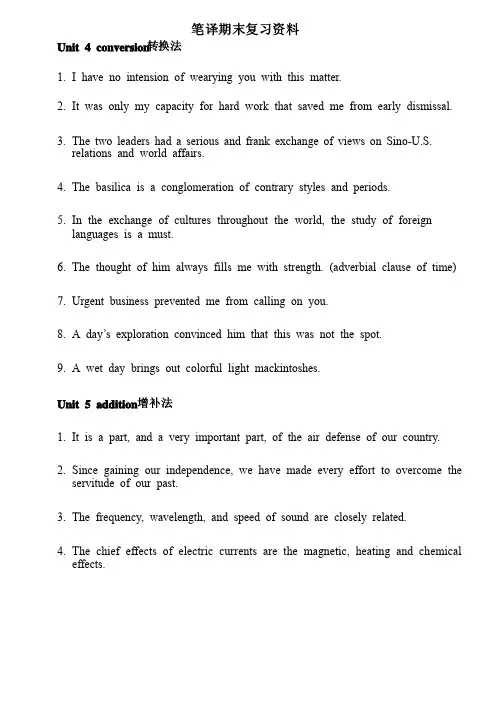
笔译期末复习资料Unit 4 conversion转换法1.I have no intension of wearying you with this matter. 2.It was only my capacity for hard work that saved me from early dismissal. 3.The The two two two leaders leaders leaders had had had a a a serious serious serious and and and frank frank frank exchange exchange exchange of of of views views views on on on Sino-U.S. Sino-U.S. relations and world affairs. 4.The basilica is a conglomeration of contrary styles and periods. 5.In In the the the exchange exchange exchange of of of cultures cultures cultures throughout throughout throughout the the the world, world, world, the the the study study study of of of foreign foreign languages is a must. 6.The thought of him always fills me with strength. (adverbial clause of time) 7.Urgent business prevented me from calling on you. 8.A day’s exploration convinced him that this was not the spot.9.A wet day brings out colorful light mackintoshes. Unit 5 addition增补法1.It is a part, and a very important part, of the air defense of our country. 2.Since gaining our independence, we have made every effort to overcome the servitude of our past. 3.The frequency, wavelength, and speed of sound are closely related. 4.The chief effects of electric currents are the magnetic, heating and chemical effects. 5. This This report report report summed summed summed up up up the the the new new new achievements achievements achievements made made made in in in electron electron electron tubes, tubes, semiconductors and components. 6. The spirit of peaceful coexistence must embody the idea that states cannot be left to struggle on single-handed. 7. Theory is something, but practice is everything. 8. The whole square was alive with singing and rejoicing. 9. He has in his vision the totality of every world problem, political, economic, human human……10. I t’s a bit fishy that she should have given away a villa like that.Unit 6 Omission省略法 1. Water passes from a liquid to solid state when it freezes. 2. You should keep calm even when you are in danger. 3. She covered her face with her hands as if to protect her eyes. 4. Turning on his face, he rested his chin on his hands. 5. Never get on or off the bus before it comes to a standstill. 6. Practically all substances expand when heated and contract when cooled. 7. As she turned the corner she had a new idea which made her stop dead. 8. It is ten to one that we will over-fulfil our production quota. 9. From 4℃ on down, water will decreasein density and increase in volume as it gets colder. 10. T here are a number of peculiarities about the surface features of the earth. 11. H e went out and shut the door gently behind him. unit 7 repetition 重复法2. 2. The The The use use use of of of atomic atomic atomic weapons weapons weapons is is is a a a clear clear clear violation violation violation of of of international international international law, law, in particular of the Geneva Convention; 3. Aerostatics is the study of how an object is supported in the air by buoyancy, that is, its ability to float in the air as a boat floats on water. 1. Despite his versatility of talent and shiftiness of purpose, this man has in his whole lifetime been wedded to the most fossilized routine. ; 2. 2. The The The solid solid solid friendship friendship friendship between between between our our our two two two countries countries countries took took took shape shape shape during during during our our protected struggles against colonialism, hegemonism, and outmoded relationships. 5. 5. Reading Reading Reading exerci exerci exercises ses ses one’s one’s one’s eyes; eyes; eyes; speaking, speaking, speaking, one’s one’s one’s tongue; tongue; tongue; while while while writing, writing, writing, one’s one’s mind.; 6. 6. Thales Thales Thales thought thought thought water water water was was was the the the beginning beginning beginning of of of everything; everything; everything; Anaximenes, Anaximenes, Anaximenes, air; air; Heraclitus, fire. 1. Radar is a newly developed technique by which people can see things beyond the visibility of them. ; 3. 3. W e W e have have have advocated advocated advocated the the the principle principle principle of of of peaceful peaceful peaceful co-existence, co-existence, co-existence, which which which is is is now now growing more and more popular among the nations of Asia and Africa. 19. He walked down the line shaking hands with each other and mumbling a few words that were inaudible.; 21. Walking up and down the empty room, he stopped here and there to touch or look. unit 8 Inversion 倒置法12. S he had such a kindly, smiling, tender, gentle, generous heart of her own.; 13. S he was an intelligent, attractive and somewhat temperamental daughter of a well-to-do doctor in Haddington. 14. T hen one can see the oval face of a handsome young woman with deep darkeyes and l ong long heavy clinging tresses. tresses. 15. B ernard Shaw was a well-known English playwright, who wrote many plays .; 16. A ir is a mixture of gases, of which oxygen forms 21 percent by volume.17. J ohn, who was sick yesterday , did not come to class.; 18. I n n a a a dispute dispute dispute between between between two two two states states with which one is friendly , , try try try not not not to to to get get involved.; 19. W e e maintain that no peace situation is permanent maintain that no peace situation is permanent which does not take into account the legitimate wishes of the majority of the people of any country.20. S he was s o so worried that she could hardly eat her supper.; 21. N ow that I think of it , we were wrong in turning down her proposal. unit 9 Negation 反译法22. S he did not l eave the letter here on purpose for you to read.; leave the letter here on purpose for you to read.; 23. Y ou cannot politely turn down the invitation to the conference. 24. U nder no circumstances would we give up our principles. would we give up our principles. 25. H e was grown into quite another creature from what he was.; 26. O ur work is still a long way from perfection.; perfection.; 27. I have read your articles. I expected to meet an older man. 28. A ll of the atoms of an element do not have exactly the same mass.; 29. E verything is not good, but equally everything is not bad. 30. I t is not to be denied that no sacrifice is too great to avert a catastrophe. to avert a catastrophe. 31. W hen I think of all the waste, words fail me. unit 10 Division拆译法 1. They relentlessly tear at the flowers they see. 2. I shall be glad of your company on the journey. 3. 3. The The The time time time could could could have have have been been been more more more profitably profitably profitably spent spent spent in in in making making making a a a detailed detailed investigation. (= if the time had been spent in making a detailed investigation, it could have been more profitable.) 4. They tried vainly to blame us for the break down in the truce talks. 5. Any comment on it should appropriately come from the Ministry of Foreign Affairs. 6. 6. Statistically Statistically Statistically significant significant significant correlation correlation correlation exists exists exists between between between vitamin vitamin vitamin deficiency deficiency deficiency and and disease. 7. 7. His His His article article article is is is a a a well-written well-written well-written composition composition composition with with with good good good organization organization organization and and and fine fine style. 8. In the doorway lay at least twelve umbrellas of all sizes and colours. 9. The difficulty of attainment increases the value of the object. 10. 10. Electronic Electronic Electronic computers, computers, computers, which which which have have have many many many advantages, advantages, advantages, cannot cannot cannot do do do creative creative work and replace man. 11. Food which is kept too long decays because it is attacked by yeasts, moulds and bacteria. 12. There is an emergency exit in the roof of the car through which passengers can escape. unit 11 Condensation 缩译法1. 1. When When When we we we praise praise praise the the the Chinese Chinese Chinese leadership leadership leadership and and and the the the people, people, people, we we we are are are not not not merely merely being polite. 2. Before the night was far advanced, they began to move against the enemy. 3. The chances are that the new machine will arrive tomorrow. 4. 4. The The The imitation, imitation, imitation, or or or make-believe, make-believe, make-believe, of of of life life life which which which poetry poetry poetry offers offers offers constitutes constitutes constitutes an an ordered whole. 5. One “Take this” is better than two “I’ll give you”.unit 12 Translation of Passive Voice 被动式译法1. Gases are frequently regarded as compressible, liquids as incompressible. 2. Many elements in nature are found to be mixtures of different isotopes. unit 13 Translation of Long Sentences 长句译法1. From the standpoint of the developing countries, the next decade should see a a greatly greatly greatly accelerated accelerated accelerated program program program for for for scien fic scien fic scien fic and and and technological technological technological co-opera on, co-opera on, aimed at wide-spread dissemina on of technology for mee ng the basic needs of man, such as nutri on, shelter, communica ons, health and sanita on. 2. The tendency of a body to continue in motion is clear to one who observes that that an an an automobile automobile automobile or or or a a a train train train moves moves moves for for for some some some distance distance distance even even even when when when brakes brakes brakes are are used to check this motion. 3. 3. There There There is is is no no no more more more difference, difference, difference, but but but there there there is is is just just just the the the same same same kind kind kind of of of difference, difference, between between the the the mental mental mental operations operations operations of of of a a a man man man of of of science science science and and and those those those of of of an an an ordinary ordinary person as there is between the operations and methods of a baker or of a butcher who who weighs weighs weighs out out out his his his goods goods goods in in in common common common scales scales scales and and and the the the operations operations operations of of of a a a chemist chemist who who performs performs performs a a a difficult difficult difficult and and and complex complex complex analysis analysis analysis by by by means means means of of of his his his balance balance balance and and finely graduated weights. 。
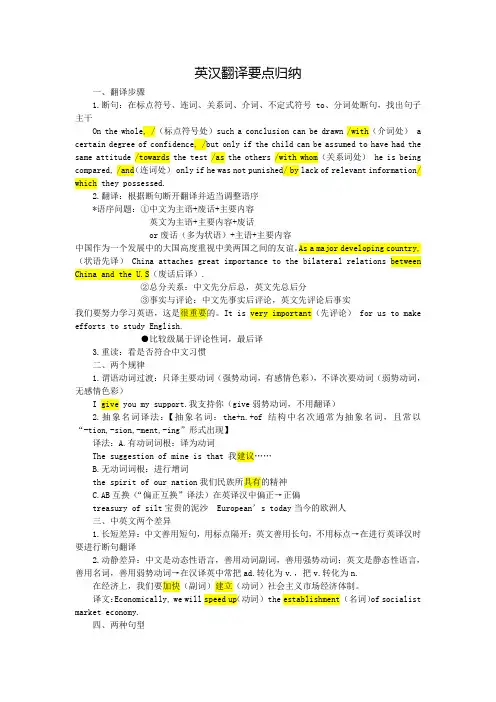
英汉翻译要点归纳一、翻译步骤1.断句:在标点符号、连词、关系词、介词、不定式符号to、分词处断句,找出句子主干On the whole, /(标点符号处)such a conclusion can be drawn /with(介词处) a certain degree of confidence, /but only if the child can be assumed to have had the same attitude /towards the test /as the others /with whom(关系词处) he is being compared, /and(连词处) only if he was not punished/ by lack of relevant information/ which they possessed.2.翻译:根据断句断开翻译并适当调整语序*语序问题:①中文为主语+废话+主要内容英文为主语+主要内容+废话or废话(多为状语)+主语+主要内容中国作为一个发展中的大国高度重视中美两国之间的友谊。
As a major developing country,(状语先译) China attaches great importance to the bilateral relations between China and the U.S(废话后译).②总分关系:中文先分后总,英文先总后分③事实与评论:中文先事实后评论,英文先评论后事实我们要努力学习英语,这是很重要的。
It is very important(先评论) for us to make efforts to study English.●比较级属于评论性词,最后译3.重读:看是否符合中文习惯二、两个规律1.谓语动词过渡:只译主要动词(强势动词,有感情色彩),不译次要动词(弱势动词,无感情色彩)I give you my support.我支持你(give弱势动词,不用翻译)2.抽象名词译法:【抽象名词:the+n.+of结构中名次通常为抽象名词,且常以“-tion,-sion,-ment,-ing”形式出现】译法:A.有动词词根:译为动词The suggestion of mine is that 我建议……B.无动词词根:进行增词the spirit of our nation我们民族所具有的精神C.AB互换(“偏正互换”译法)在英译汉中偏正→正偏treasury of silt宝贵的泥沙 European’s today当今的欧洲人三、中英文两个差异1.长短差异:中文善用短句,用标点隔开;英文善用长句,不用标点→在进行英译汉时要进行断句翻译2.动静差异:中文是动态性语言,善用动词副词,善用强势动词;英文是静态性语言,善用名词,善用弱势动词→在汉译英中常把ad.转化为v.,把v.转化为n.在经济上,我们要加快(副词)建立(动词)社会主义市场经济体制。
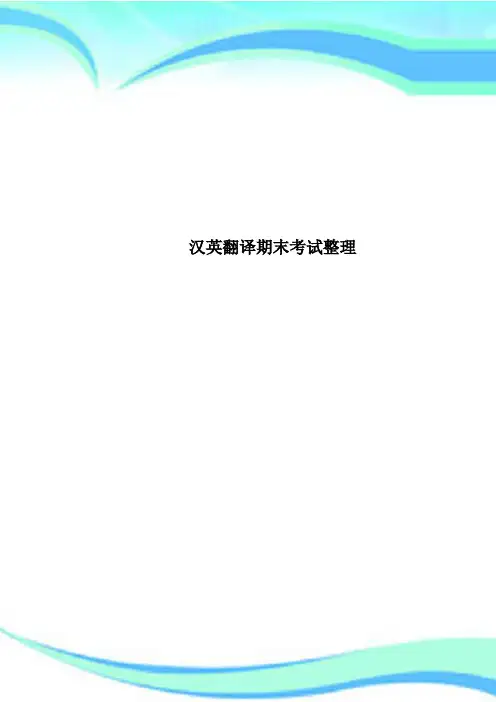
汉英翻译期末考试整理————————————————————————————————作者:————————————————————————————————日期:她望着蔚蓝的大海。
She looked at the blue sea.武行者心中要吃,哪里听他分说,一声喝道:“放屁!放屁!”Pass your wind! Nonsense彩云红雨暗长门,翡翠枝余萼绿痕。
As rainbow clouds o’er darkened door, red petals shower,On jadeite branch is left the trace of fallen flower.接受竟成了劫搜。
Taking-over turns out to be loot-taking.他们种庄稼和葡萄,酿酒和饮酒,喂牛和挤奶,锄草。
(1)They plant crops and grapevines, brew and drink wines, feed and milk cows, and weed and plant the garden.(2) They plant crops and grapevines, brew wine to drink, feed cows to milk and weed the garden to grow flowers.(3) They plant crops and grapevines, brew wine for drink, feed cows for milk and weed the garden for flowers.(4)They plant crops and grapevines, do the gardening, brew wine for drink, and feed cows for milk.去教堂祈祷和做礼拜They go to the church to pray and attend church service.They go the church, praying and attending church service.到广场拉琴、跳舞和唱歌a. They play the violin, dance and sing.b. They play the violin, dancing and singing.c. They play dance and sing to the violin.21世纪前10年,是中国民航承前启后,继往开来的重要时期。
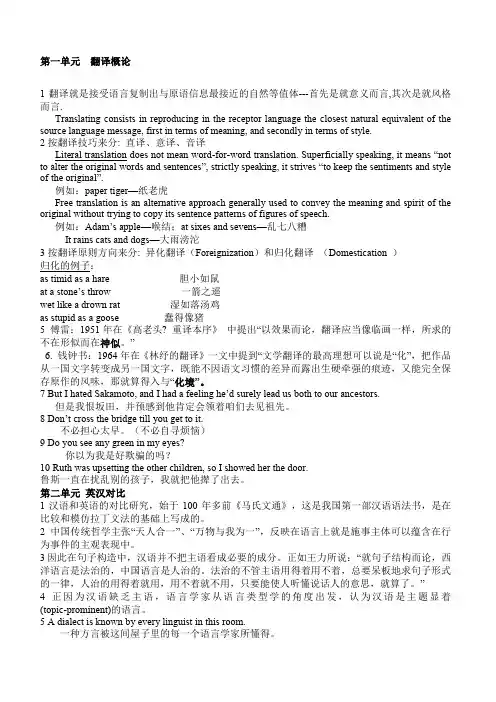
第一单元翻译概论1翻译就是接受语言复制出与原语信息最接近的自然等值体---首先是就意义而言,其次是就风格而言.Translating consists in reproducing in the receptor language the closest natural equivalent of the source language message, first in terms of meaning, and secondly in terms of style.2按翻译技巧来分: 直译、意译、音译Literal translation does not mean word-for-word translation. Superficially speaking, it means “not to alter the original words and sentences”, strictly speaking, it strives “to keep the sentiments and style of the original”.例如:paper tiger—纸老虎Free translation is an alternative approach generally used to convey the meaning and spirit of the original without trying to copy its sentence patterns of figures of speech.例如:Adam’s apple—喉结;at sixes and sevens—乱七八糟It rains cats and dogs—大雨滂沱3按翻译原则方向来分: 异化翻译(Foreignization)和归化翻译(Domestication )归化的例子:as timid as a hare 胆小如鼠at a stone’s throw 一箭之遥wet like a drown rat 湿如落汤鸡as stupid as a goose 蠢得像猪5 傅雷:1951年在《高老头 重译本序》中提出“以效果而论,翻译应当像临画一样,所求的不在形似而在神似。

1. 鱼,我所欲也,熊掌,亦我所欲也;二者不可得兼,舍鱼而去熊掌者也。
As delicacies, both fish and bear’s paws are what I want. But if I were forced to choose between them, I would prefer the latter to the former(But if I had only one alternative…)2. (…黄发垂髫,并怡然自乐。
)见渔人,乃大惊;问所从来,具答之。
(The villagers, both old and young, looked happy and pleased with themselves.)Upon seeing the fisherman, they were startled, asking from where he came, and he answered their question patiently.3. 抚军亦厚赉成。
不岁数,田百顷,楼阁万椽,牛羊各千计。
As a compensation for his loss of son. Fujun(the military officer)bestowed him a big favor by giving him a lot of money. A few years later he became a man of property, owning hundreds of hectares of farmland, numerous spacious houses, and a large flock of sheep and cattle.4. 项王泣数行下,左右皆泣,莫能仰视。
Xiang, the military lord, wept his loss of the battle, with tears running down on his face. His attendant generals and soldiers, lowering their heads, just followed suit.5. 子以我为不信,吾为子先行,子随我后,观百兽之见我而敢不走乎?If you don’t believe me, I will show you my prowess. Please you walk after me, and you’ll see all the beasts be scared away by my presence.6. 明日,徐公来,熟视之,自以为不如;窥镜而自视,又弗如远甚。
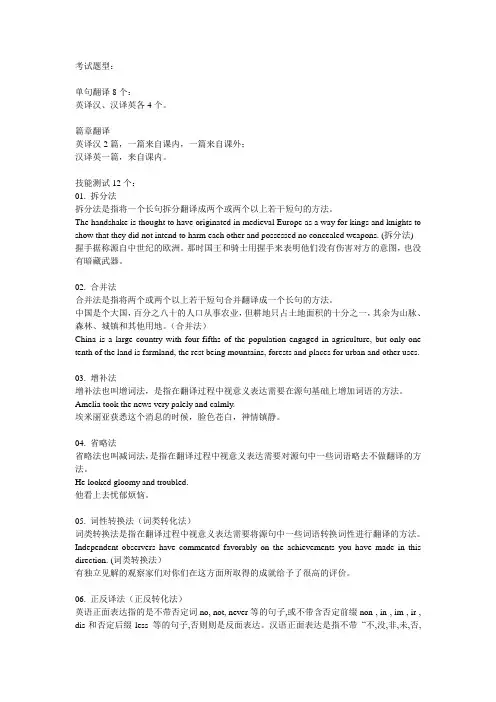
考试题型:单句翻译8个:英译汉、汉译英各4个。
篇章翻译英译汉2篇,一篇来自课内,一篇来自课外;汉译英一篇,来自课内。
技能测试12个:01. 拆分法拆分法是指将一个长句拆分翻译成两个或两个以上若干短句的方法。
The handshake is thought to have originated in medieval Europe as a way for kings and knights to show that they did not intend to harm each other and possessed no concealed weapons. (拆分法)握手据称源自中世纪的欧洲。
那时国王和骑士用握手来表明他们没有伤害对方的意图,也没有暗藏武器。
02. 合并法合并法是指将两个或两个以上若干短句合并翻译成一个长句的方法。
中国是个大国,百分之八十的人口从事农业,但耕地只占土地面积的十分之一,其余为山脉、森林、城镇和其他用地。
(合并法)China is a large country with four-fifths of the population engaged in agriculture, but only one tenth of the land is farmland, the rest being mountains, forests and places for urban and other uses.03. 增补法增补法也叫增词法,是指在翻译过程中视意义表达需要在源句基础上增加词语的方法。
Amelia took the news very palely and calmly.埃米丽亚获悉这个消息的时候,脸色苍白,神情镇静。
04. 省略法省略法也叫减词法,是指在翻译过程中视意义表达需要对源句中一些词语略去不做翻译的方法。
He looked gloomy and troubled.他看上去忧郁烦恼。
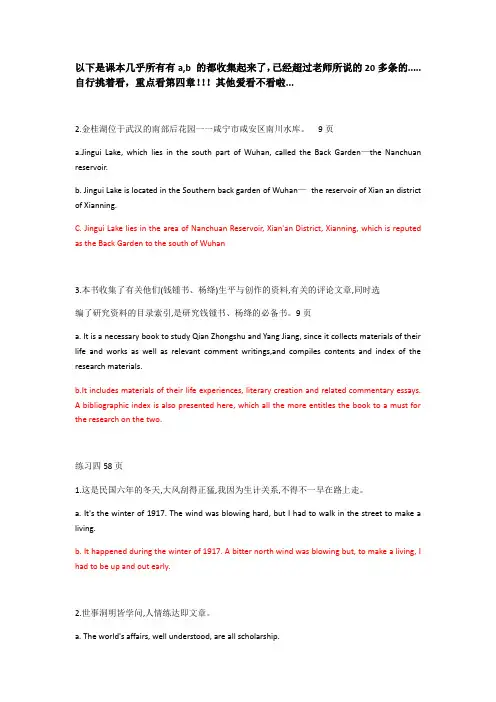
以下是课本几乎所有有a,b 的都收集起来了,已经超过老师所说的20多条的.....自行挑着看,重点看第四章!!!其他爱看不看啦...2.金桂湖位于武汉的南部后花园一一咸宁市咸安区南川水库。
9页a.Jingui Lake, which lies in the south part of Wuhan, called the Back Garden—the Nanchuan reservoir.b. Jingui Lake is located in the Southern back garden of Wuhan—the reservoir of Xian an district of Xianning.C. Jingui Lake lies in the area of Nanchuan Reservoir, Xian'an District, Xianning, which is reputed as the Back Garden to the south of Wuhan3.本书收集了有关他们(钱锺书、杨绛)生平与创作的资料,有关的评论文章,同时选编了研究资料的目录索引,是研究钱锺书、杨绛的必备书。
9页a. It is a necessary book to study Qian Zhongshu and Yang Jiang, since it collects materials of their life and works as well as relevant comment writings,and compiles contents and index of the research materials.b.It includes materials of their life experiences, literary creation and related commentary essays.A bibliographic index is also presented here, which all the more entitles the book to a must for the research on the two.练习四58页1.这是民国六年的冬天,大风刮得正猛,我因为生计关系,不得不一早在路上走。
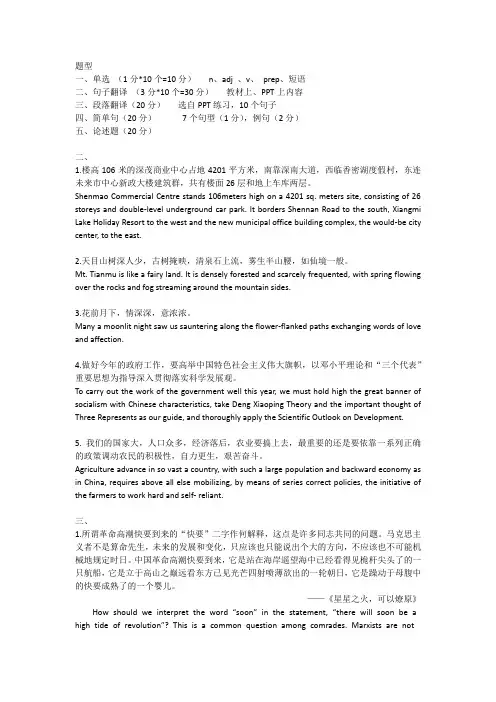
题型一、单选(1分*10个=10分)n、adj、v、prep、短语二、句子翻译(3分*10个=30分)教材上、PPT上内容三、段落翻译(20分)选自PPT练习,10个句子四、简单句(20分)7个句型(1分),例句(2分)五、论述题(20分)二、1.楼高106米的深茂商业中心占地4201平方米,南靠深南大道,西临香密湖度假村,东连未来市中心新政大楼建筑群,共有楼面26层和地上车库两层。
Shenmao Commercial Centre stands 106meters high on a 4201 sq. meters site, consisting of 26 storeys and double-level underground car park. It borders Shennan Road to the south, Xiangmi Lake Holiday Resort to the west and the new municipal office building complex, the would-be city center, to the east.2.天目山树深人少,古树掩映,清泉石上流,雾生半山腰,如仙境一般。
Mt. Tianmu is like a fairy land. It is densely forested and scarcely frequented, with spring flowing over the rocks and fog streaming around the mountain sides.3.花前月下,情深深,意浓浓。
Many a moonlit night saw us sauntering along the flower-flanked paths exchanging words of love and affection.4.做好今年的政府工作,要高举中国特色社会主义伟大旗帜,以邓小平理论和“三个代表”重要思想为指导深入贯彻落实科学发展观。
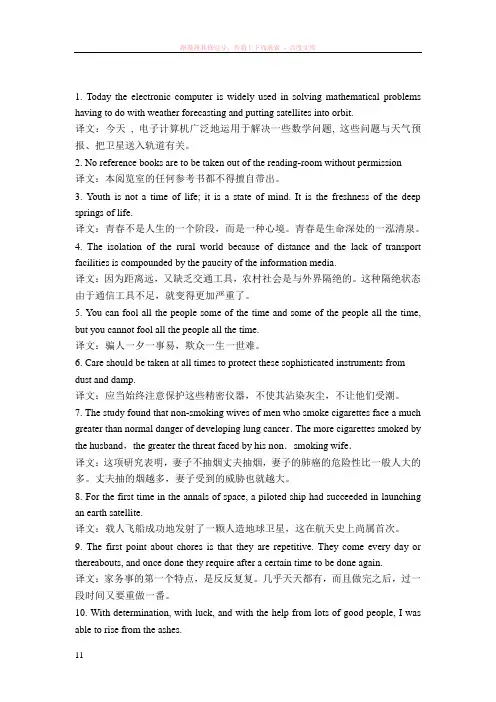
1. Today the electronic computer is widely used in solving mathematical problems having to do with weather forecasting and putting satellites into orbit.译文:今天, 电子计算机广泛地运用于解决一些数学问题, 这些问题与天气预报、把卫星送入轨道有关。
2. No reference books are to be taken out of the reading-room without permission译文:本阅览室的任何参考书都不得擅自带出。
3. Youth is not a time of life; it is a state of mind. It is the freshness of the deep springs of life.译文:青春不是人生的一个阶段,而是一种心境。
青春是生命深处的一泓清泉。
4. The isolation of the rural world because of distance and the lack of transport facilities is compounded by the paucity of the information media.译文:因为距离远,又缺乏交通工具,农村社会是与外界隔绝的。
这种隔绝状态由于通信工具不足,就变得更加严重了。
5. You can fool all the people some of the time and some of the people all the time, but you cannot fool all the people all the time.译文:骗人一夕一事易,欺众一生一世难。
6. Care should be taken at all times to protect these sophisticated instruments from dust and damp.译文:应当始终注意保护这些精密仪器,不使其沾染灰尘,不让他们受潮。
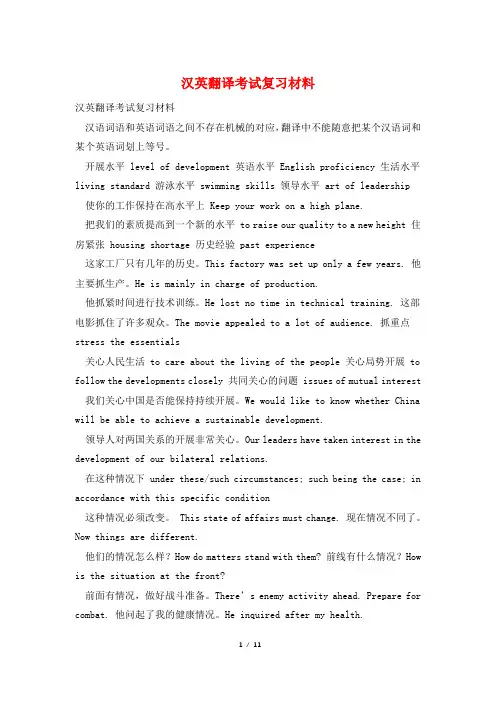
汉英翻译考试复习材料汉英翻译考试复习材料汉语词语和英语词语之间不存在机械的对应,翻译中不能随意把某个汉语词和某个英语词划上等号。
开展水平 level of development 英语水平 English proficiency 生活水平living standard 游泳水平 swimming skills 领导水平 art of leadership 使你的工作保持在高水平上 Keep your work on a high plane.把我们的素质提高到一个新的水平 to raise our quality to a new height 住房紧张 housing shortage 历史经验 past experience这家工厂只有几年的历史。
This factory was set up only a few years. 他主要抓生产。
He is mainly in charge of production.他抓紧时间进行技术训练。
He lost no time in technical training. 这部电影抓住了许多观众。
The movie appealed to a lot of audience. 抓重点stress the essentials关心人民生活 to care about the living of the people 关心局势开展 to follow the developments closely 共同关心的问题 issues of mutual interest 我们关心中国是否能保持持续开展。
We would like to know whether China will be able to achieve a sustainable development.领导人对两国关系的开展非常关心。
Our leaders have taken interest in the development of our bilateral relations.在这种情况下 under these/such circumstances; such being the case; in accordance with this specific condition这种情况必须改变。
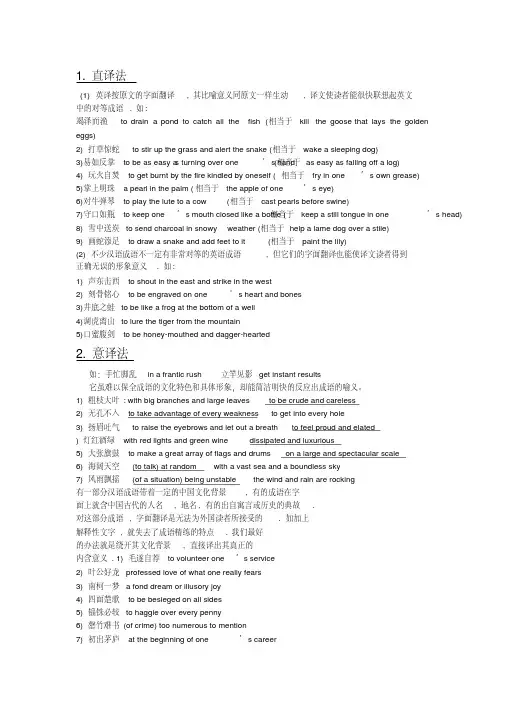
1. 直译法(1) 英译按原文的字面翻译, 其比喻意义同原文一样生动, 译文使读者能很快联想起英文中的对等成语. 如:竭泽而渔to drain a pond to catch all the fish (相当于kill the goose that lays the goldeneggs)2) 打草惊蛇to stir up the grass and alert the snake (相当于wake a sleeping dog)(相当于as easy as falling off a log)3)易如反掌to be as easy a s turning over one’s hand4) 玩火自焚to get burnt by the fire kindled by oneself (相当于fry in one’s own grease)5)掌上明珠 a pearl in the palm (相当于the apple of one’s eye)6)对牛弹琴to play the lute to a cow (相当于cast pearls before swine)7)守口如瓶to keep one’s mouth closed like a bottle (相当于keep a still tongue in one’s head)8) 雪中送炭to send charcoal in snowy weather (相当于help a lame dog over a stile)9) 画蛇添足to draw a snake and add feet to it (相当于paint the lily)(2) 不少汉语成语不一定有非常对等的英语成语, 但它们的字面翻译也能使译文读者得到正确无误的形象意义. 如:1) 声东击西to shout in the east and strike in the west2) 刻骨铭心to be engraved on one’s heart and bones3)井底之蛙to be like a frog at the bottom of a well4)调虎离山to lure the tiger from the mountain5)口蜜腹剑to be honey-mouthed and dagger-hearted2. 意译法如:手忙脚乱in a frantic rush 立竿见影get instant results它虽难以保全成语的文化特色和具体形象,却能简洁明快的反应出成语的喻义。
第三章名词的抽象和具体译法第一节名词的抽象译法(p68)粗枝大叶to be crude and careless (with big branches and large leaves)海阔天空to talk with random( with a vast sea and boundless sky)灯红酒绿dissipated and luxurious (with red lights and green wine)纸醉金迷of life of luxury and dissipation (with drunken paper and bewitched gold)单枪匹马to be single-handed in doing sth (with a solitary spear and a single horse)赤胆忠心ardent loyalty (with red gut and heart)无孔不入to take advantage of every weakness (to get into every hole)扬眉吐气to feel proud and elated (to raise the eyebrows and let out a breath)开门见山to come straight to the point (to open the door and see the mountain)大张旗鼓on a large and spectacular scale (to make a great array of flags and drums)风雨飘摇(of a situation) being unstable (the wind and rain are rocking)二.翻译下列句子(1)这是他们夫妻之间的事情,你去插一脚干吗?That’s a business of their own, between husband and wife. Why should you get involved in? (2)别人家里鸡零狗碎的事情你都知道得这么全,真是个顺风耳啊!You know all the bits and pieces of trifles of other families. You are really well informed. (3)这消息让我出了一身冷汗。
1. 直译法(1) 英译按原文的字面翻译, 其比喻意义同原文一样生动, 译文使读者能很快联想起英文中的对等成语. 如:竭泽而渔to drain a pond to catch all the fish (相当于kill the goose that lays the golden eggs)2) 打草惊蛇to stir up the grass and alert the snake (相当于wake a sleeping dog)3)易如反掌to be as easy a s turning over one’s hand (相当于as easy as falling off a log)4) 玩火自焚to get burnt by the fire kindled by oneself (相当于fry in one’s own grease)5)掌上明珠a pearl in the palm (相当于the apple of one’s eye)6)对牛弹琴to play the lute to a cow (相当于cast pearls before swine)7)守口如瓶to keep one’s mouth closed like a bottle (相当于keep a still tongue in one’s head)8) 雪中送炭to send charcoal in snowy weather (相当于help a lame dog over a stile)9) 画蛇添足to draw a snake and add feet to it (相当于paint the lily)(2) 不少汉语成语不一定有非常对等的英语成语, 但它们的字面翻译也能使译文读者得到正确无误的形象意义. 如:1) 声东击西to shout in the east and strike in the west2) 刻骨铭心to be engraved on one’s heart and bones3)井底之蛙to be like a frog at the bottom of a well4)调虎离山to lure the tiger from the mountain5)口蜜腹剑to be honey-mouthed and dagger-hearted2. 意译法如:手忙脚乱in a frantic rush 立竿见影get instant results它虽难以保全成语的文化特色和具体形象,却能简洁明快的反应出成语的喻义。
1) 粗枝大叶: with big branches and large leaves to be crude and careless2) 无孔不入to take advantage of every weakness to get into every hole3) 扬眉吐气to raise the eyebrows and let out a breath to feel proud and elated) 灯红酒绿with red lights and green wine dissipated and luxurious5) 大张旗鼓to make a great array of flags and drums on a large and spectacular scale6) 海阔天空(to talk) at random with a vast sea and a boundless sky7) 风雨飘摇(of a situation) being unstable the wind and rain are rocking有一部分汉语成语带着一定的中国文化背景, 有的成语在字面上就含中国古代的人名, 地名, 有的出自寓言或历史的典故.对这部分成语, 字面翻译是无法为外国读者所接受的. 如加上解释性文字, 就失去了成语精练的特点. 我们最好的办法就是绕开其文化背景, 直接译出其真正的内含意义. 1) 毛遂自荐to volunteer one’s service2) 叶公好龙professed love of what one really fears3) 南柯一梦a fond dream or illusory joy4) 四面楚歌to be besieged on all sides5) 锱铢必较to haggle over every penny6) 罄竹难书(of crime) too numerous to mention7) 初出茅庐at the beginning of one’s career8) 倾国倾城to be exceedingly beautiful9) 悬梁刺股to be extremely hard-working in one’s study10) 东施效颦crude imitation with ludicrous effect3.套译法。
指套用译语中某个与汉语成语喻义相近的成语来进行翻译的方法。
可分为:1) 两个成语的字面意义和蕴含意义基本一致。
如:赴汤蹈火go through fire and water七颠八倒at sixes and sevens滴水穿石constant dripping wears away the stone垂头丧气in low spirits杂乱无章out of order英雄所见略同Great minds think alike.2) 两个成语的比喻形象有所差异,但比喻意义基本一致。
如:小题大做make a mountain out of a molehill洗心革面turn over a new leaf过河拆桥kick down the ladder乳臭未干be wet behind the ears,格格不入be like square pegs in round holes大发雷霆blow one’s top横行霸道throw one’s weight about物以类聚Birds of a feather flock together.一文不名without a penny to one’s name弱不禁风as weak as water山穷水尽at the en d of one’s rope扬眉吐气to hold one’s head high3) 汉语成语原本是翻译的产物,因此可直接以英语成语回译之。
如:君子协定a gentleman’s agreement滚石不生苔A rolling stone gathers no moss.吠犬不咬人 A barking dog never bites.火中取栗pull the chestnuts out of the fire4.加注法。
它是在译文中添加读者理解成语所需的文化信息和背景知识,其特点在于既能保留成语的比喻形象和文化蕴含,又能确保译文容易为译语读者所理解接受。
5.增译法。
指在译文中直接增补理解成语所需的相关信息。
总而言之, 翻译汉语成语时, 为了保留原文形象, 能直译则尽量直译, 即按字面翻译;不能直译时, 我们也不能因词害义, 可以翻译其实际意义;如能在英文中找到意义完全对等的成语, 我们也可采用这种套译法。
一般来说, 正规文体中, 汉语成语多采用形象的逐字翻译;非正规文体中, 多采用简洁的大意翻译。
.6.2 四字格的翻译策略四字格又称四字结构,是汉语的一种独特的词汇现象。
它是由四个汉字组成的词语。
其词语内部的组合关系也相对稳定。
四字格包括汉语中所有四个字组成的词语结构,也就包括了四字成语。
虽然成语也有三字成语和多字成语,但大多数成语是四字结构,因此四字格和成语的翻译方法有不少共同之处。
但值得注意的是,有不少四字结构或前后两部分意义重复,或前后两部分只具备整体意义。
翻译时只需译出一个意义或整体意义,以避免译文累赘。
如生动活泼lively 光辉灿烂brilliant植树造林afforestation 繁荣昌盛prosperous丰功伟绩great achievements风调雨顺good weather for the crops声嘶力竭o shout oneself hoarse 心灰意懒to feel disheartened 鸡皮疙瘩goose-flesh天长地久as old as the hills总之,四字格的翻译是灵活多样的,既要照顾形式,也不必拘泥于形式。
但也不能完全不顾形式造成滥译和误译,必须以语义相符、功能相似为客观标准,尽可能使译文自然、贴切,可读性强。
如以下四字格及供参考译文:质地优良to be excellent in quality / with superior quality品种齐全in complete range of articles 选料考究choice material做工精细fine workmanship 色泽鲜明bright-colored货到付款payment against arrival 名牌产品name brand product驰名中外to be popular both at home and abroad 久负盛名with a long standing reputation万古流芳will be remembered throughout the age名垂青史to go down in history家喻户晓o be widely known假冒产品fake goods伪劣产品low-quality goods欢迎订购order welcome投资热点investment hot spot敬请光临You’re i nvited to come.工业园区industrial Park经济特区special economic zone土地租赁land lease国有资产state assets无形资产intangible assets物价指数price-rise index开拓进取to work hard with a pioneering spirit德才兼备with both professional ability and political integrity公平竞争fair competition国家机关state agency惩治腐败to combat corruption暂行条例interim regulations合法权益lawful right and interest 长治久安to maintain long-term stability3.6.2. 谚语的翻译(一) 直译方法, 把原文的内容,形式和精神都输入到译文中去, 努力减少翻译中的损失。